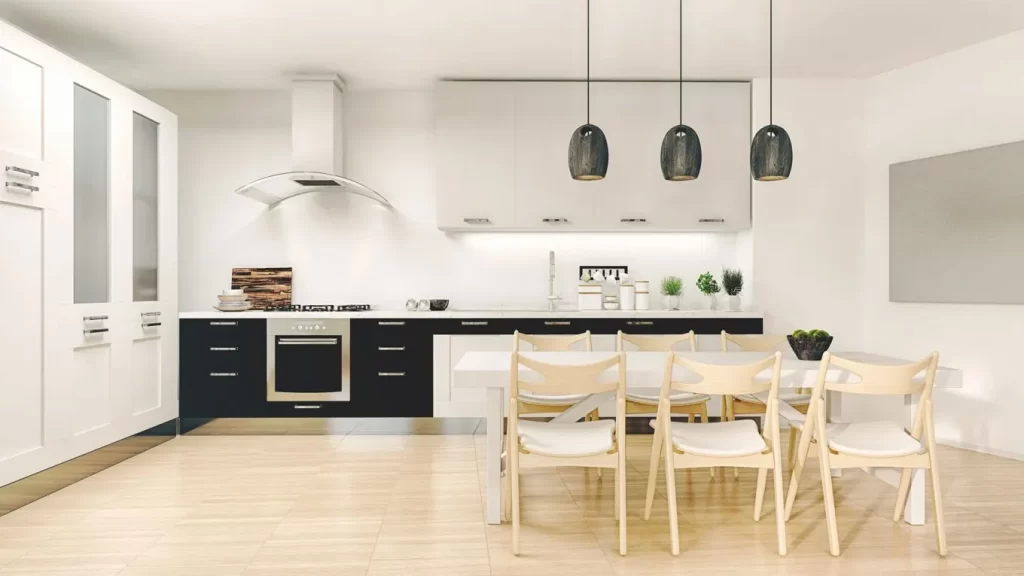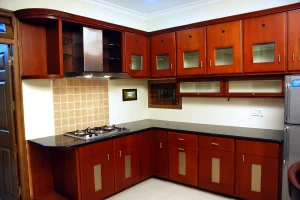Kitchen Flooring Options Pros and Cons

Kitchen flooring options come in a variety of styles and materials. The right choice will depend on your personal preference and lifestyle needs, as well as resale value.
Laminate flooring mimics the look of various materials and is resistant to scratches, stains, and moisture, making it an ideal option for busy areas prone to spills and heavy foot traffic. It is also affordable and easy to install.
Laminate
Laminate has a water-resistant surface, meaning you don’t need to worry about dropping a pan or a drink spilling. The downside is that it can’t be refinished and tends to warp if it is subjected to standing water for long periods of time.
It’s also not as durable as tile and hardwood floors. Additionally, laminate doesn’t increase resale value as much as solid wood or tile flooring.
Hardwood
Hardwood flooring is a traditional choice for kitchens, and still a popular one. It adds warmth, richness and elegance to the room, and is especially well suited for open-space contemporary homes.
Choose hickory or oak for wood floors in the kitchen, as these have a high Janka hardness rating, making them more resistant to water damage. Be sure to seal them regularly with an oil-based polyurethane.
Keep in mind that hardwoods will expand and contract as the temperature and humidity rise and fall, so proper installation is critical. Work with a flooring and remodeling professional, like your partners at The Good Guys, to identify considerations such as subfloor type and installation method.
Vinyl
Despite the negative associations with old-school vinyl, this resilient flooring is actually hard-wearing and a great kitchen option. It’s easy to clean and is less expensive than tile or stone. It also feels warmer and more comfortable underfoot than stone or concrete, and is forgiving of dropped crockery.
Kitchen floors need to be water resistant to withstand steam, spillages and moisture from food preparation and washing up. Sheet vinyl and Luxury Vinyl Tiles (LVT) are both water-resistant flooring options, as are ceramic or stone tiles.
Solid wood isn’t as suited to the kitchen as it is in other areas of the home, as it expands and contracts when exposed to humidity and temperature changes. However, engineered wood does not have this problem and is an excellent kitchen flooring choice.
Cork
Cork flooring is a natural product made from ground and compressed bark, which means it’s a green option. It’s also hypoallergenic and resistant to bacteria, mold, mildew and pests. It contains a compound called suberin that makes it naturally fire-resistant.
Its inherent softness makes it easier to stand in than wood or linoleum, which is a plus for comfort-conscious homeowners. It’s easy to clean and is fairly durable, but it can be scratched or abraded by sliding furniture legs and grit-covered footwear. It needs to be re-coated with polyurethane every 3 to 10 years, depending on how much traffic it gets. It can also fade in direct sunlight.
Concrete
Unlike tile, which may be prone to cracking and grout failure, concrete is extremely durable. Dropped pans, spilled food and heavy foot traffic can be easily handled by this flooring type.
Concrete floors are easy to keep clean, with a weekly mopping and re-sealing being all that’s needed. The material is also non-combustible and has a high fire resistance rating.
Concrete can be stained, etched, or polished to create a modern style that fits any kitchen design. It’s a great option for those who want a one-of-a-kind floor that can be customized with various pigments, finishes, acid etching and stamp overlays. It’s also environmentally friendly, as reusing the existing concrete slab minimizes waste.
Linseed Oil-Based Finishes
Linseed oil-based finishes saturate deeply into wood to provide a durable protective layer that highlights the natural color and grain of a wood surface. However, linseed oil needs regular reapplication—at least once per year—to look its best and offer peak durability.
Woodworkers can choose raw linseed oil or polymerized (boiled) linseed oils, which contain metallic drying additives to reduce curing times. Both of these types offer good durability but can darken the wood over time.
Tung oil provides a better alternative because it is nontoxic, offering a food-safe material for kitchens. It also offers more water resistance than linseed oil. A wood finish with tung oil can be cleaned with a damp cloth or a mixture of water and vinegar.






